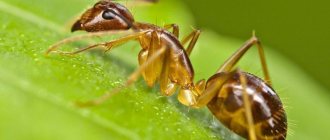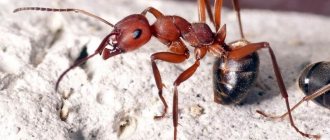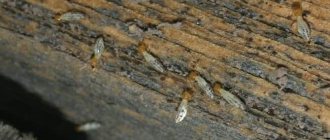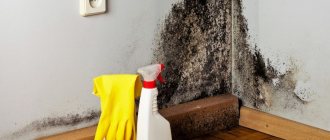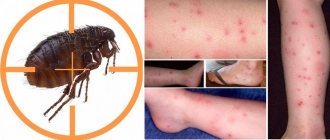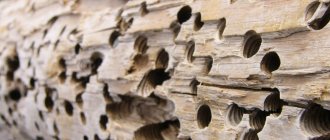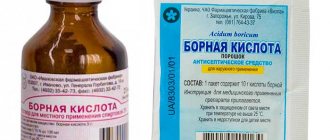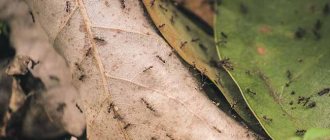Silverfish are insects from the bristletail order. Their genus includes only three species:
- Lepisma baetica
- Lepisma chlorosoma
- Lepisma saccharina
Lepisma saccharina, also known as the common, sugar, silverfish or simply silverfish, is the only species that is found in Russia; the other two live in the tropics. In nature, silverfish are busy processing organic matter, which they feed on, but sometimes they penetrate into rooms and remain there for a long time. What do they need in your home? Why and where do these insects come from? How to distinguish them from other similar pests and how to get rid of silverfish in an apartment?
Calculator
Calculate the cost of exterminating insects in the house
Number of rooms:
(Cold fog)
(Cold Fog + Barrier Defense)
(Hot fog + Premium drugs + Barrier protection)
(Hot fog + VIP drugs + Barrier protection)
Total cost: 01
Order processing
Sugar silverfish: description
If you think that you have a sugarfish in your apartment, a description of its appearance and habits along with a photo will help you be sure whether it is it.
What does it look like
- Lepisma saccharinum has a round, flattened, elongated body, gradually tapering from head to tail.
- The body length of an adult individual usually reaches 1 centimeter; in particularly favorable conditions, insects can be slightly larger.
- The body is covered with chitinous plates that overlap one another like armor.
- The color of silverfish, depending on the stage of development, can vary from white to dark gray with a metallic tint. The older the silverfish, the darker it is.
- The head is crowned with two long mustaches, often equal in length to the size of the body.
- In the caudal part there are soft cerci directed to the sides and a long caudal filament in the center.
- The insect has three pairs of legs.
How it moves
- Moves in jerks, alternating running with short stops.
- Due to the position of the legs, during movement the insect’s body bends and wags like a fish’s tail.
- Due to its physiological characteristics, silverfish can only run on horizontal and inclined surfaces; they are not capable of reliably clinging to a wall or ceiling with their paws.
- The silverfish quickly runs away if the light is suddenly turned on in the room where it is located.
How it lives and reproduces
- Silverfish larvae look exactly the same as adults, but are smaller in size - on average 0.5 millimeters or more, depending on the stage of development.
- The larvae are always lighter than adults; they can be white, pearl-colored, or silver.
- Over the course of her entire life, each female silverfish lays about 100 eggs.
- At temperatures around 22° C, the larvae hatch from the eggs after about 40 days, at temperatures close to 32° C - after 20 days.
- The sugar silverfish larva develops to adulthood in approximately 1 year.
- If the silverfish does not die for reasons beyond its control, it can live up to 8 years.
- At temperatures of +5° C and below, Lepisma saccharinum can go into suspended animation and survive in this state without food for 9–12 months.
- Silverfish can molt up to 60–70 times in their lifetime, including as adults up to the age of 4 years.
Silverfish are sometimes confused with woodlice and two-tailed fish. Woodlice are rounder and have 7 pairs of legs, not 3, double-tailed ones are darker and larger, their cerci in the tail are harder, the insect can use them as a weapon, lifting them up and spreading them to the sides. Silverfish are not aggressive and always prefer to hide from any threat, exposure to sunlight and electric light.
Traces of an insect's presence
Home thermobia, the photo of which you see in the article today, is the real enemy of all book publications that are on the shelves, be they books or archival documents. These insects have special digestive enzymes that allow them to process the paper they eat into nutrients. If silverfish have gnawed books, then these places will be disfigured by fungus, turn yellow or blacken.
These insects, like all others, leave their excrement. If there are a lot of them in the apartment, then you can see a real trail of black grains. They can leave their feces or eggs in flour, sugar, or on bread. Agree, the prospect is not very rosy.
Causes of silverfish in the apartment
Silverfish can get into an apartment:
- Do it yourself, using ventilation shafts, grooves and cracks in communication wiring, cracks around windows and thresholds.
- Accidentally end up in packaging, bags or purchased goods.
- Cling to clothes, shoes, or get into your bag if you are in the place where they live for a long time.
- Arrive on pet fur after a walk or trip to the country.
- Live on houseplants and get into the house with a new potted flower.
If silverfish crawl on their own, then, as a rule, they live either in the nearest basement, or with neighbors, or on the street. In nature, Lepisma saccharinum lives under fallen leaves, stones, and in cracks in stone and cement masonry. In search of food in the summer, insects may well crawl into rooms, especially on the first few floors of a building.
The reasons for the occurrence of silverfish in an apartment cannot always be determined for certain, but this is not critically necessary information for pest control. What is much more important is why insects remain once they get into the apartment. For a comfortable life, they need a special environment and combination of conditions. For silverfish it is:
- Warm, optimally in the range of 22–27° C.
- High humidity – from 75% and above.
- Darkness.
- Secluded places, areas, crevices where you can hide.
- Water and suitable food.
The diet of silverfish includes foods rich in carbohydrates, in particular polysaccharides. In residential areas, silverfish can eat:
- Millet, oats, rye, barley
- Lentils, mung beans, peas, chickpeas
- Hair, exfoliated skin particles, dandruff
- Sugar and products containing it
- Paper, photographs, plaster
- Fibers of fabrics, clothing, interior items
- Remains of dead insects
- Chitinous coverings shed during molting
- Microorganisms growing in moist environments
- Decaying green houseplants
In search of food, silverfish are able to travel distances that are quite large for their body size, although they still try to somehow optimize their movements and, if possible, reduce their distance. Most often, silverfish can be found in an apartment in the bathroom, shower, toilet or kitchen. They can also be in rooms, but somewhere nearby there must be a dark, warm and secluded place with a high level of humidity. A crack next to a leaking battery or a flower pot with constantly waterlogged soil on the windowsill would be perfect for its role.
Prevention
To prevent silverfish from appearing on your territory in the future, follow a number of rules:
- in the bathroom, pantry, kitchen, seal all the cracks with putty, then the insect will not be able to build masonry there;
- Clean regularly: get rid of dust, dirt, old trash. Pack clothes you don't use in vacuum bags. Do not collect construction debris, glue residues, or dust in the corners and under the bathroom;
- After use, the bathroom should be ventilated from condensation. Wipe wet surfaces dry immediately, and dry rugs regularly in the fresh air;
- Don’t be lazy and install forced ventilation in places with high humidity to be able to get rid of suspended water in the air;
- store bulk cereals, flour, sugar in sealed glass containers;
- Keep your bookshelves clean: dust regularly, go over with a damp cloth and sometimes spray with safe anti-silverfish products. For example, alum solution.
As you can see, preventing an attack is not so difficult - it’s enough to keep your home clean and not clutter up. But if pests do get into your home, use these tips and the problem will be easily fixed.
Are silverfish dangerous for humans?
Silverfish:
- Don't bite
- Don't drink blood
- Are not carriers of diseases
However, like any other insects, silverfish live in contaminated places - sewers, ventilation, soil and come into contact with decaying organic matter. Their bodies, shed chitinous coverings, and excrement may contain harmful bacteria that can cause a local allergic reaction on the skin upon contact and lead to gastrointestinal problems if you eat foods that the silverfish have eaten.
Whether silverfish are dangerous to humans, things and objects in the house largely depends on their numbers. The more insects, the more often they come into view and the more abundant the amount of dirt from them. In addition, a large number of pests require more food, and damage to fabrics, clothes and objects can become noticeable. In order not to bring the situation to a critical scale, you need to start destroying pests as soon as you notice them. The sooner you start doing this, the easier and faster you will be able to get rid of insects.
Types of traps
If you have experience in catching cockroaches or other insects, then we can say that the specifics practically do not change.
- Jar trap. It is not necessary to take glass; metal or plastic will work well. The point is very simple. The outside walls are wrapped with masking tape so that insects can easily climb up. The inside walls are lightly greased with sunflower oil, and bread or sugar is placed on the bottom. They will not get back along the smooth walls. You can add a little water to the bottom and place the bait on a hill.
- Newspaper trap. A proven method that has already been tried by thousands of people. The newspaper needs to be rolled up and secured with rubber bands to prevent it from unwinding. After this, it is moistened with water in which sugar is dissolved. Insects will gnaw through the layers and go for a walk through the labyrinths in search of food. In the morning, the newspaper will need to be thrown away or burned.
- There are inexpensive sticky traps available for sale. They are universal and work against any insects.
Silverfish: how to get rid of an apartment - effective ways
To get rid of silverfish completely and permanently, it is necessary to combine preventive measures with extermination measures. In general, your pest control plan should look like this:
- Determine where pests accumulate and live by observing them and inspecting areas with a suitable environment.
- Change the microclimate in the apartment so that it becomes unsuitable for pests - first of all, reduce the humidity level.
- Carry out massive baiting of silverfish using selected means and methods.
- Isolate the house as much as possible from the penetration of insects by eliminating minor damage in the apartment and cosmetic or major repairs.
The last step is relevant in the prevention and control of any type of pests, therefore, by using the recommendations from this category, you will protect your home not only from silverfish, but also from much more harmful and dangerous insects that can encroach on it. What exactly is silverfish afraid of, how to get rid of it in an apartment, and what effective methods exist for this?
How to remove home thermobia from the kitchen
Food is stored here, so the use of chemicals is highly undesirable. A description of domestic thermobia would be incomplete if it were not to say that insects come out to feed at night. It is this time that we will use to catch adult insects.
Setting traps is an effective and safe way to combat them. Moreover, they can be made from scrap materials without spending money on buying similar ones in the store. They will not spoil the interior of your apartment, since they can only be displayed at night and checked in the morning. To do this, choose the darkest and dampest corners where insects are most likely to appear. We must not forget that somewhere there may already be clutches of eggs. Therefore, traps alone may not be enough; disinfection of the room remains a prerequisite.
Regulation of humidity, heat and microclimate
Reducing humidity and adjusting temperature is necessary no matter what method of pest control you choose. A special device for measuring humidity levels will help you track accurate indicators - a hygrometer or thermohygrometer, which, along with humidity, also shows temperature. You can reduce humidity by:
- Air dryer installations
- heater
- Heated towel rail
- Frequent ventilation
The level of humidity in the bathroom is greatly influenced by the state of ventilation, so if there is excess condensation, it is necessary to clean it first.
Folk, improvised, natural remedies
Cedar oil
Cedar oil repels but does not kill silverfish. You can soak cotton pads in oil and place them in places where you often see insects, or prepare a mixture of 500 milliliters of water and 10-15 drops of oil, which you then spray on surfaces.
Helpful advice
Silverfish do not like the smell of any coniferous plants, so to repel them, you can use bags of fresh spruce and pine needles, as well as sawdust for rodents and wood fillers for cat litter made from coniferous wood.
Place pine needles, sawdust or pellets in areas where you often see pests. Sawdust and granules need to be changed once a week; bags of pine needles can be left for a year. Cinnamon
The smell of cinnamon repels silverfish. A suitable source is cinnamon sticks, powder or oil, which is mixed with water in a spray bottle and applied to surfaces where silverfish run.
Citrus
Oranges, lemons and other citrus fruits help repel silverfish, especially when fresh when the smell is most intense. You can use both skins and pulp. Once a week, replace dried cuttings with fresh ones so that the intensity of the smell does not decrease. You can make a surface treatment spray from lemon juice and water.
Carefully!
Lemon juice can lighten fabrics and surfaces.
Before applying it to any material, test the solution on an inconspicuous area or, if in doubt, choose an alternative method. Cucumber skins
Cucumber peels affect silverfish in a similar way to citrus and are used in the same way.
Bay leaves
Dried bay leaves help repel pests. They are especially convenient to use in kitchen cabinets.
Carnation
When fighting silverfish, cloves as a spice are suitable. The inflorescences must be placed in places where insects are found in the apartment. Cloves can also be used in the form of oil, soaking cotton pads in it or preparing a spray with it, however, the smell of cloves is very concentrated. Before you apply it to anything in your home, make sure you like it. It will be difficult to remove it from surfaces and objects.
Why use silverfish repellents?
Repellents are essentially absolutely useless in the fight against most types of pests, but in the case of silverfish, it makes sense to use them.
With their help, you can scare away pests from products and objects that they can spoil. To do this, you need to lay out and apply all repellents close to the places and things that you want to protect from insects. For example, in cupboards with cereals, in a drawer with dirty things in the bathroom, in closets with clothes, etc. Salt
The integument of the silverfish's body is quite thin, so any contact with salt can cause harm to the insect, even death. You can sprinkle salt directly on insects, or in places where you often see them. Leave the salt for a week, then vacuum it up. Repeat the procedure several times, tracking changes.
Diatomite
Diatomaceous earth, diatomaceous earth or diatomaceous earth acts on insects in the same way as salt, but works faster and more intensely. Diatomaceous earth must be scattered in areas where silverfish live. When contacting it, pests will die from dehydration.
note
Diatomite works only in a dry state.
It is advisable to scatter the powder in places where there is no strong draft, otherwise it will scatter throughout the apartment. Boric acid
From boric acid powder and starch-containing products, you can make food baits for silverfish and place them in small portions on substrates in places where the insects live. Mix boric acid powder with food bait in a 1/1 ratio. Suitable attractants with a high starch content are:
- Corn grains
- Rice
- Beans
- Potato
- Bananas
Food and acid must be mixed until smooth before use.
Carefully!
Place food baits only where pets and small children cannot reach them, or choose alternative baiting methods.
Baits with boric acid, if they enter the gastrointestinal tract, are equally dangerous for people, animals, and insects. Household cleaning products
Any household cleaning products, especially those based on chlorine, can destroy the integument of silverfish. Use them regularly to clean the bathroom, bathroom fixtures, and tiles.
What home methods are ineffective, what to do
The most ineffective method of control is the use of orange peel and fresh cucumbers.
The most ineffective method of control is the use of orange peel and fresh cucumbers.
These components can produce a short-term repellent effect while their smell spreads, so they need to be changed regularly, which is inconvenient.
An ambiguous method of control is also exposure to cold.
At an air temperature of -10 ˚C, adults and their larvae die, but to create these conditions in a room, you need to open the windows and balcony door wide in severe frost and wait for 1-2 hours, which is not acceptable. Such a rash decision can cause deformation of the heating pipes.
It is better to use proven insecticides, traps and folk remedies. It is worth finding a source of high humidity. By eliminating it, you can ensure that the insects themselves leave the room without the use of various drugs.
Insecticides
Insecticides in the form of aerosols, sprays and concentrates are suitable for treating silverfish habitats, for example, such as:
- August Cucaracha Spray
- Concentrate Medilis-Super
- Aerosol Clean House from skin beetles
- Raid Max aerosol
- Combat SuperSpray
Using any glue-based insect traps on substrates is also effective. They will need to be changed periodically as they become dirty.


